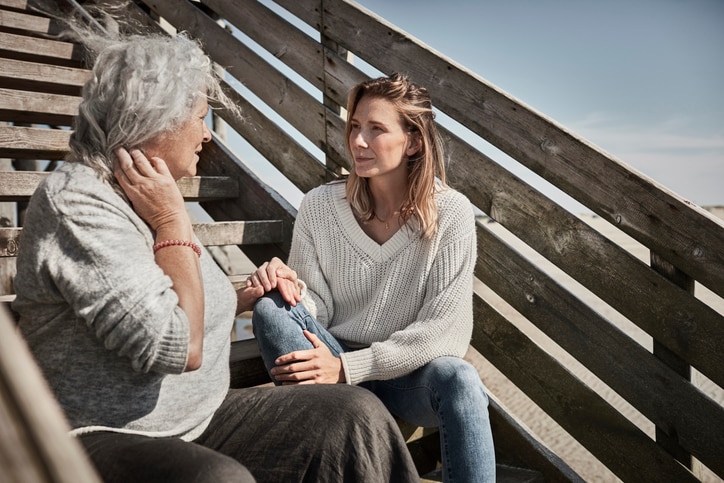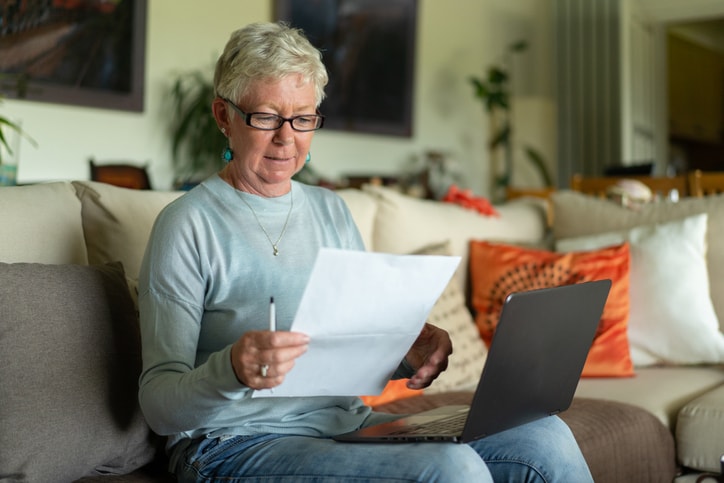In this article
When Jennifer Molidor’s mother was struck by a car, both of their lives changed in an instant. Molidor’s mother had permanent physical and mental disabilities as a result of the accident, and Molidor herself was forced to leave her job as a tenure track professor at a Midwest university to return home to Sonoma County, California, and become the default manager of her mother’s care.
Caring for her mom meant Molidor spent her days picking up medications, preparing meals, dealing with insurance companies and trying to juggle her own schedule and personal life. “I did everything,” she says. “I also endured being the sole recipient of my parent’s fear, anger, confusion and stress.”
Molidor has a brother and other relatives, but like a lot of female caregivers, she says she was mostly left to handle her mother’s care needs alone. “I found that whether it’s a partner or a sibling, if they’re a cisgender male, they sort of automatically do less to help out,” she says. “I had a difficult relationship with my mother, yet the gendered division of labor meant I did everything.”
Molidor’s story is, unfortunately, not uncommon. An estimated 40 million adults in the U.S. serve as family caregivers, and two out of three caregivers are women. Caring for an aging parent or loved one is difficult for anyone, but it’s even harder when the division of labor in your family is unequal. To get to the bottom of why this dynamic exists and what to do about it, we spoke with experts about how women can feel more empowered to create a more equal caregiving workload with their male siblings, partners and extended family.
Key takeaways
- An estimated 44% of caregivers work full-time, and 24% have children at home. This means that if you’re also a senior caregiver, you’re going to need help.
- Women often shoulder the bulk of caregiving due to societal expectations, but trying to ‘do it all’ as a caregiver can lead to burnout, stress and poor mental health.
- As a caregiver, it’s important to delegate tasks, discuss your goals and needs with other family members and seek outside caregiving support when needed.
Why caregiving duties fall on women
Society says women are natural caregivers or more nurturing than men, points out Alyssa Westring, an associate professor of management at DePaul University and the author of “Parents Who Lead.” “While that’s not necessarily true, men and women can internalize those messages,” she notes.
“It’s not only that sometimes men are not stepping up. It’s also that women feel obligated to step up more, and the men around them let it happen.”
— Alyssa Westring, associate professor and author
These internalized beliefs create two big problems in caregiving scenarios. First, some parents may expect their daughters will be the ones to naturally step into the caregiver role, according to Westring. “Whether parents are saying it intentionally or unconsciously, they may be communicating that ‘you’ll be the one who takes care of me,’ or ‘I know you’ll take care of me in my old age,’” she says. “That creates a lot of pressure.”
Second, women may feel a greater sense of responsibility for caregiving, which leads them to take on more than is reasonable. “It’s not only that sometimes men are not stepping up,” Westring says. “It’s also that women feel obligated to step up more, and the men around them let it happen.”
The problem with female caregivers “doing it all”
Just because you, your parents or your extended family have the expectation that you’ll be able to handle most of the caregiving doesn’t mean that’s fair or right. In fact, it may actually be harmful to your self esteem and mental health.
Allison Chawla, a licensed clinical psychotherapist in New York, says women in this position may be at risk of anxiety, depression, low self-esteem or burnout. “No one has the ability to give 100% of themselves to 100% of everything all of the time,” she says. “Expecting anyone to ‘do it all’ is setting them up for inevitable failure.”
How to create a more equal caregiving workload
So how can you set boundaries, ask for help and get the people around you to step up? Here’s what the experts suggest.
1. Make the invisible load more visible
You know you’re doing a lot, but are the people around you fully aware of everything you have on your plate? “We can end up building a lot of resentment and frustration when we do work that maybe we haven’t articulated is getting done because it tends to be more invisible,” Westring says.
Rather than carrying out every small, invisible task, such as shopping for supplies or scheduling appointments, start openly discussing what needs to be done and who exactly will be responsible for it. Westring says it can be as simple as saying, “I’m picking up the new medications. Who’s keeping track of when the medications run out and requesting refills?”
Chawla recommends creating a shared calendar to manage tasks. “Make one that keeps a schedule and has notifications so no one needs to take on the responsibility of reminding the other,” she says.
2. Focus on teamwork, not competition
When addressing disparities in caregiving duties, the discussion doesn’t need to involve scorekeeping about who does more or airing a list of grievances. Rather, it should be about aligning your core values and expectations.
“It’s emotional labor to try to convince people to do more stuff,” Westring says. “Start to talk about not just the tasks, but what do we value, what do we care about and how do we live that? Then, it’s easier to get people on board with making a change in their behaviors, as opposed to just feeling like you’re nagging people.”
If you’re aren’t sure how to have these conversations successfully, Chawla suggests:
- Gently mentioning that you feel like the current load is too much for you to carry on your own.
- Asking if they’d be up for talking about a plan you can both commit to trying.
- Getting their input about what tasks they’re able and willing to help with.
- Using words like ‘we’ and ’together’ instead of saying ‘you’, which can come across as accusational.
“The earlier you get on the same page with parents and partners and siblings about what matters most and what you really want and need from each other, the earlier you can be prepared for any crisis that may arise and lay the groundwork for a more egalitarian relationship.”
— Alyssa Westring
3. Don’t wait until you’re overwhelmed to ask for help
“If you wait until everyone’s in crisis, it’s going to be really hard to say, ‘Now let’s sit down and have a conversation about our expectations and core values,’” Westring says.
Ideally, conversations about expectations, roles and duties should happen at the start of a caregiving journey, but that isn’t always possible. If you were placed in this role suddenly or your responsibilities have spiraled out of control, make time to talk about it as soon as you can.
“For many of us, elder care will last months and years,” Westring says. “The earlier you get on the same page with parents and partners and siblings about what matters most and what you really want and need from each other, the earlier you can be prepared for any crisis that may arise and lay the groundwork for a more egalitarian relationship.”
4. Get real about priorities and expectations
Almost every caregiver is playing multiple roles. An estimated 44% of caregivers work full-time, and 24% have children at home. Achieving balance will mean getting clear about what truly matters. “Look at the expectations that you have of yourself and challenge which of those are essential and which ones you could let go of, outsource or find an alternative to,” Westring says.
This could mean:
- Paying for items like medication or groceries to be delivered.
- Turning down unnecessary work projects or taking time off, if possible.
- Creating a schedule with siblings for visiting your parent.
- Designating specific days or hours to spend only with your kids.
- Setting aside specific time to practice self-care.
“Not everything is negotiable, but some things may be,” Westring adds. “Ask yourself: What is most important, and how can I direct my energy and my attention to those things?”
5. Don’t be afraid to seek outside support
For Jennifer Molidor, hiring caregivers was essential to preserving her mental health while caring for her mom. “I recommend including a caregiver in daily or semi-weekly visits because this person doesn’t have the same exhaustion, stress or overwhelm that you may be experiencing,” she says.
An outside caregiver can ease multiple burdens at once, including:
- Providing additional social interaction to your loved one.
- Helping your loved one find independence through outings, like walks, trips to the library or running errands.
- Giving you regular breaks from full-time care duties.
- Easing family strain from caregiving conflicts.
Medicare or Medicaid may be able to help cover the cost of short-term senior care. Additionally, it may be helpful to discuss care needs with your siblings or other family members and decide on a way to split the cost.
A final caregiving tip from an expert
The important thing to remember is that it’s not a weakness to ask for help, and you don’t have to do it all by yourself. As Chawla says, “It is not only OK, but is a form of self preservation to say that things are just too much for you to handle alone.”





